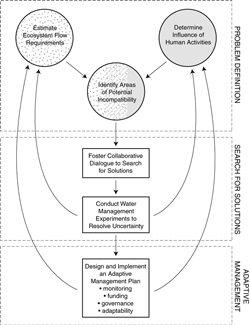Streamflow Management
Alteration of natural river flows resulting from the construction and operation of dams can result in substantial changes to downstream aquatic and bottomland ecosystems and undermine the long-term health of native species and communities. Increasingly, land and water managers are seeking ways to manage reservoir releases to produce flow regimes that simultaneously meet human needs while also maintaining the health and sustainability of downstream biota. On the Bill Williams River (BWR), there have been several efforts over the past 15 years to evaluate links between different releases from Alamo Dam and resulting ecological conditions.
In the early 1990’s, a group of interested parties recognized that conflicts between stakeholders were likely regarding Alamo Dam operations, and that any approach to re-operating Alamo Dam had to provide a means to resolve these likely disagreements. This effort culminated in the 1994 endorsement of a new approach to managing Alamo Dam and the issuance of a new Water Control Manual by the Corps in December of 2003.
By the end of the 1990’s, it had become clear that improvements could be made to existing hydrologic models of reservoir operations, and that a comprehensive adaptive management and monitoring plan to assess dam operations needed to be developed and implemented. These facts have served as motivators to renew the commitment to advance the understanding of this unique waterway, focusing on the impressive advancements made in river science over the past decade.
One of the most important signs of the renewed commitment to bring the best science forward to advance the management of this river system comes in the form of the Sustainable Rivers Project, a national collaboration between The Nature Conservancy and the U.S. Army Corps of Engineers (“Corps”). This joint-effort between TNC and the Corps states that:
 “The goal is not to create optimal conditions for all species all of the time; rather, we want to create adequate conditions for all native species enough of the time.”
“The goal is not to create optimal conditions for all species all of the time; rather, we want to create adequate conditions for all native species enough of the time.”
Because Alamo Dam is one of 10 Corps facilities in the U.S. that are part of this far-reaching effort, the BWR is the recipient of leveraged resources that greatly enhances the width and breadth of the work that can be engaged. The flowchart above illustrates the approach that is helping to guide efforts on the BWR. Using this approach, flow releases from Alamo Dam are being adjusted to meet a variety of natural resource objectives, including the enhancement of cottonwood-willow riparian areas and flood control. Similarly, the implementation of adaptive management through this approach facilitates the evaluation of management efforts and encourages making necessary adjustments to better achieve a sound balance between various management objectives above and below Alamo Dam.
![]() This site was constructed by the U.S. Geological Survey Fort Collins Science Center
This site was constructed by the U.S. Geological Survey Fort Collins Science Center
